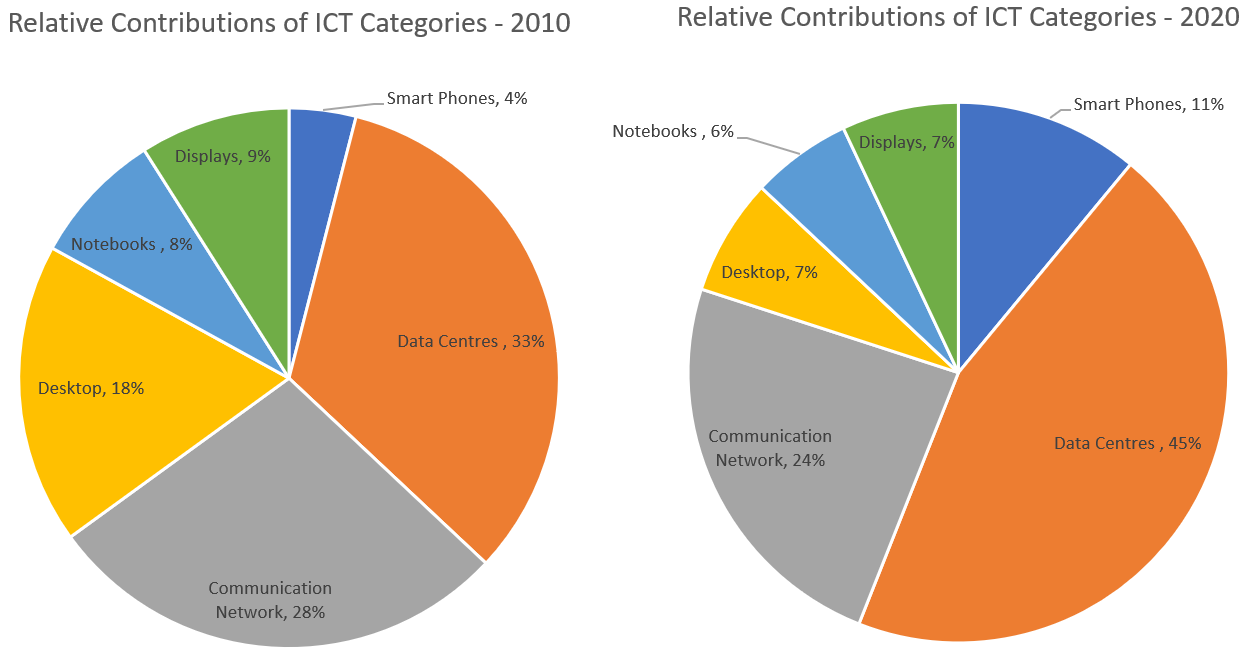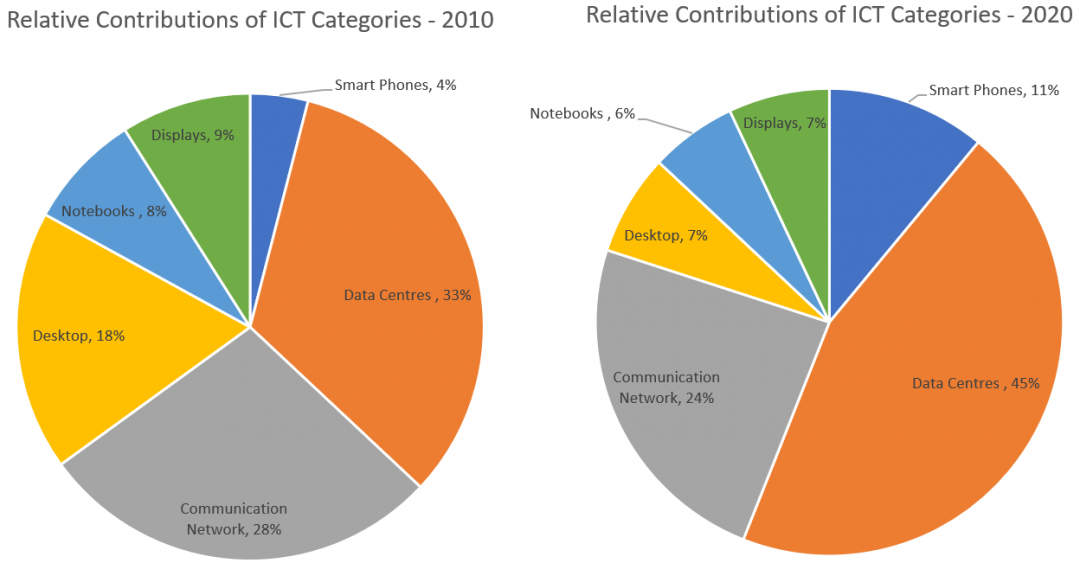Could clicks becoming more dangerous for the planet than cars?
Blog: Capgemini CTO Blog
Information and comms technology (ICT) doesn’t feel like an obvious CO2 villain. There’s no smoke belching out of your phone, and the industry’s leading players cultivate the clean-living, progressive image that we largely believe in.
The problem, of course, is that all that glossy white high technology uses electricity, which has to come from somewhere. And that some of its components are very carbon intensive to obtain.
Today ICT accounts for ~2–3%[1.2] of global CO2 emissions (some suggest more[3]). This may not sound like much, but it’s on a par with the aviation industry’s emissions from fuel[4], which is a far more common target for criticism.
It has become so quick and easy to move data around that we rarely think about the energy it uses. A study funded by the European Commission[5] highlighted a striking example: in 2018 the music video Despacito became the first in YouTube history to breach five billion views. The energy required to serve up that one video five billion times was equal to the energy used by 40,000 US households in one year[6].
So, ICT already has a sustainability issue, but it’s likely to get a lot worse as data volumes snowball in the coming decade. Every byte requires energy to generate and manipulate. Today, ICT accounts for about 10%[7] of global electricity demand, but that’s expected to rise to 20%[8] (some models say 50%[9]) by 2030.
If these models are correct, and the industry does nothing to mitigate, ICT could contribute 20% of global CO2 emissions within the next 10–15 years[10]. That’s more than global road transport today (~18%) [11] [12].
What’s using all this energy?
ICT is a large and complex conglomeration of devices and infrastructure. Before we can think about tackling the problem, we need to understand which parts of this complex landscape are the biggest culprits.
A detailed study in 2015 revealed the breakdown of ICT’s carbon footprint, and how it has changed over the past decade[13].

Two things really stand out: the dramatic increase in smart phones’ slice of the pie, and the huge impact of data centers. The report’s authors note: “in absolute terms, the GHGE emissions of smart phones grew from about 17 MteCO2-e in 2010 to 125 MteCO2-e in 2020, representing a 730% increase in the span of 10 years.” This is driven by the increasing number of smart phones, but also by the very high carbon cost of their manufacture and short useful lifespans – in other words, it takes a lot of carbon to make a phone that will probably be thrown away after just a couple of years.
The other big contributors, less surprisingly, are data centers and communications networks. Together, they accounted for 61% of the footprint in 2010 and the projection for 2020 is 69%. These are the backbone of the internet, where the data we use is stored, computed, and transferred.
Data centers use a lot of power because they hold a lot of data. Some studies put total global data storage at ~ 33 zettabytes, increasing six-fold to ~ 175 zettabytes by 2025[14]. Of this data, an estimated 80% of is stored in data centers and only 20% on devices. By 2025, many analysts expect that to invert – 80% on devices and 20% in data centers. More edge computing in this scenario may further impact the carbon load.
The introduction of 5G will have an impact on the communications networks segment. The essential problem is that the greatly increased data volume 5G promises means increased power use. There are proposals for mitigating this, but the situation remains unclear as the infrastructure is still being designed.
What can we do about it?
It’s not all bad news. ICT power predictions are highly speculative. They may be overestimated, or greatly impacted by geopolitical developments. Much is still open[14]. Many minds are already focused on ICT sustainability:
- An EU report[16] found potential to reduce ICT carbon emissions in the EU by more than 1.5 Gt CO2e by 2030 – 2.7 times more than the carbon emissions of the entire UK in 2012[17]. This savings would be equivalent to almost 19 times the expected footprint of the EU’s ICT sector in 2030, or 37% of the EU’s total emissions in 2016.
- A report by the Global e-Sustainable Initiative (GeSI) noted that there is potential for a 20% reduction in global CO2e emissions by 2030[18].
- Even though end user devices will increase in number by 12% every year until 2030[19], there are suggestions that their total electricity usage will decrease by ~30%[20].
In part 2, I will look at the specifics of how these savings could be achieved, and how we can act in our industry to help.
[1] https://www.greencarcongress.com/2018/03/20180306-mcmaster.html
[2] https://www.capgemini.com/gb-en/2019/10/applying-technology-to-sustainability-challenges/
[3] https://www.electronicsilentspring.com/wp-content/uploads/2015/02/ICT-Global-Emissions-Footprint-Online-version.pdf
[4] https://theicct.org/publications/co2-emissions-commercial-aviation-2018
[5] https://www.bbc.co.uk/news/technology-45798523
[6] https://fortune.com/2019/09/18/internet-cloud-server-data-center-energy-consumption-renewable-coal/
[7] http://www.electronicsilentspring.com/wp-content/uploads/2015/02/ICT-Global-Emissions-Footprint-Online-version.pdf
[8] https://www.nature.com/articles/d41586-018-06610-y
[9] https://www.mdpi.com/2078-1547/6/1/117
[10] https://www.iea.org/reports/digitalisation-and-energy
[11] https://www.iea.org/reports/digitalisation-and-energy
[12] https://www.capgemini.com/wp-content/uploads/2020/03/Report-The-automotive-industry-in-the-era-of-sustainability.pdf
[13] http://www.electronicsilentspring.com/wp-content/uploads/2015/02/ICT-Global-Emissions-Footprint-Online-version.pdf
[14] https://www.seagate.com/files/www-content/our-story/trends/files/idc-seagate-dataage-whitepaper.pdf
[15] http://emag.directindustry.com/how-is-the-coronavirus-affecting-the-tech-industry/
[16] https://www.btplc.com/Purposefulbusiness/Ourapproach/Ourpolicies/ICT_Carbon_Reduction_EU.pdf
[17] http://cait.wri.org/
[18] https://www.gesi.org/research/smarter2030-ict-solutions-for-21st-century-challenges
[19] https://cdn.ihs.com/www/pdf/IoT_ebook.pdf
[20] https://www.mdpi.com/2078-1547/6/1/117
Leave a Comment
You must be logged in to post a comment.








